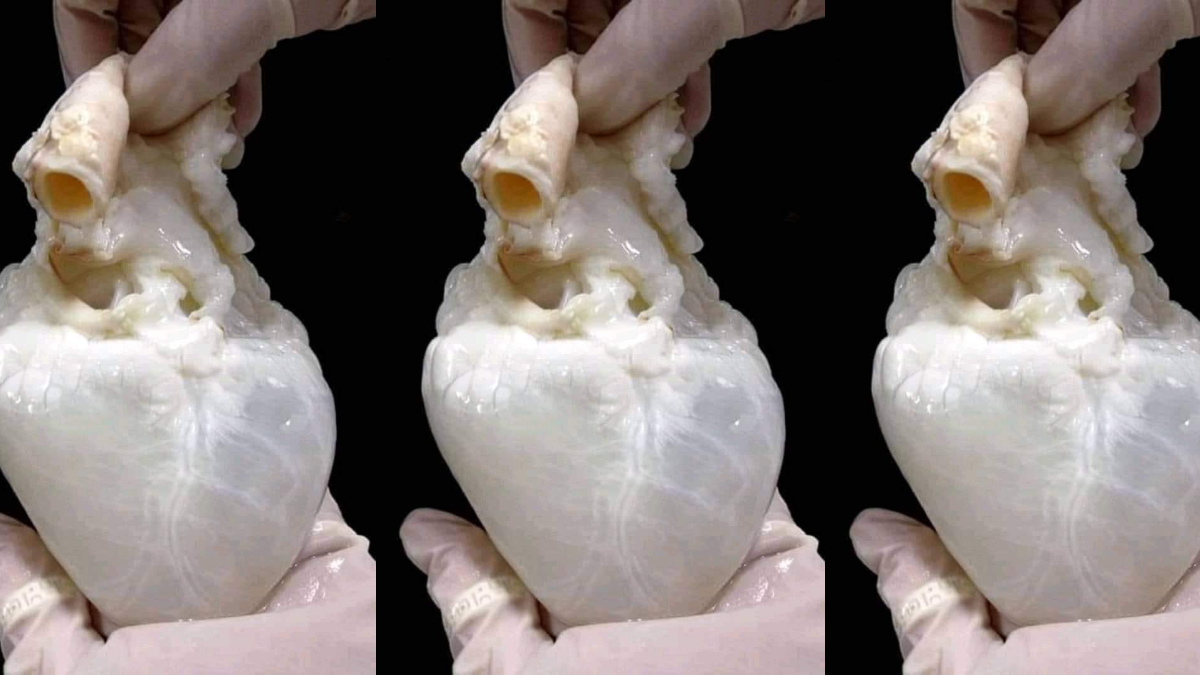The photograph was genuine and showed a so-called "ghost heart" — that is, what scientists call hearts without cells used for research. But the image did not show a human heart, as the above post on X suggested. Rather, it was a decellularized pig heart.
Images of a so-called ghost heart — a stark white, seemingly human organ completely void of red cellular structure — have circulated online since 2012.
One such example included a photo shared to X (archived here) on Jan. 24, 2024, that showed a pair of gloved hands holding an eerily white, opaque heart said to be a human heart when "all the blood is drained from it." At the time of this publication, the post had received more than 100,000 views:
This is what a human heart looks like when all the blood is drained from it. pic.twitter.com/VRcdgRurDb
— Curiosity (@MAstronomers) January 25, 2024
The photograph was genuine and showed a so-called "ghost heart" — that is, what scientists call hearts without cells used for research. But the image did not show a human heart, as the above post on X suggested. Rather, it depicted a decellularized pig heart that was cleansed of cells, Dr. Doris Taylor, a regenerative medicine researcher and bioengineer of the heart, told Snopes. As such, we rated this claim "Mixture."
A reverse-image search using Tineye (archived here) led Snopes to a blog published to TED on Feb. 14, 2015, (archived here) that described a "decelluarized 'ghost heart'":
This heart can serve as a scaffold upon which to grow a working heart from human stem cells. Researchers at the Texas Heart Institute … have successfully implanted tissue-engineered hearts into rats and pigs so far. They hope ultimately to create personalized human hearts and help relieve the shortage of donor organs.
Snopes determined through a Google-keyword search of "ghost heart Taylor" that the earliest iteration of the photograph was from an Aug. 19, 2012, article on Cleveland.com.
Taylor, who in 2024 led the research company Organamet Bio, told Snopes the photograph depicted a pig heart she and other researchers had decellularized. Such structures are used to engineer what are known as biological scaffolds for regenerative medicine research. Taylor said photographs of the in-question heart were taken on April 16, 2012.
Decellularized Hearts and Regenerative Medicine
Decellularized pig hearts are used to create biological scaffolds, which are organs and other organic material from animals that had their cellular content removed but maintain the structure of the organ itself. They are used in regenerative medicine to help determine ways to grow tissues and organs in laboratories that could one day be transplanted into humans.
"Regenerative medicine may be defined as the process of replacing or 'regenerating' human cells, tissues or organs to restore or establish normal function," the Association for the Advancement of Blood & Biotherapies website says. "This field holds the promise of regenerating damaged tissues and organs in the body by replacing damaged tissue or by stimulating the body's own repair mechanisms to heal tissues or organs."
Growing a heart in a lab setting is particularly challenging because heart cells don't divide on their own and can't repair themselves. Stem cells, on the other hand, can divide.
Because ghost hearts are devoid of cellular content, they provide a blank — but structured — slate for stem cells to adhere to, and eventually grow into, a living, functioning heart. Called "biocradles," these machines can receive food, oxygen, nutrients, and they operate with an artificial blood flow to mimic the human body.
The Making of a Ghost Heart
The in-question ghost heart was described in a 2019 blog published by the Texas Heart Institute, for whom Taylor was a researcher, as being "void of color, drained of blood and cells," and with only "its natural scaffold of extracellular matrix, fully intact."
A ghost heart is created by flushing a heart with a mild detergent that washes through blood vessels to remove cells.
Collecting human hearts for such research is difficult because it requires deceased donors. Also, thousands of people are waiting for a heart transplant in the U.S., so using a heart for research — not those patients — is typically not the highest priority when one becomes available.
To do their regenerative-medicine research, Taylor and her research team initially used rat hearts before moving to pig hearts, which are similar in size and structure to human hearts.
"We have put human cells on many dozens of porcine scaffolds and that encompasses our clinical product. For them we can choose a scaffold size to match a patient, biologic sex to best match declared gender, relative age to match pediatric patients, etc. They — pig scaffolds — provide the best option for personalized bioengineered human hearts," Taylor told Snopes in an email.
The research remains ongoing, and viable lab-grown hearts that can be transplanted into humans will not be available anytime soon, Taylor said at the Imagine Solutions conference in April 2023 (archived here). Eventually, though, she hopes to create personalized human hearts as unique as the people who need them.

